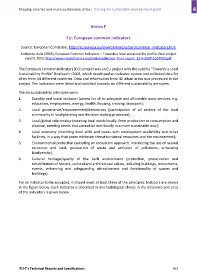Page 867 - Shaping smarter and more sustainable cities - Striving for sustainable development goals
P. 867
Annex F
EU: European common indicators
Source: European Comission, http://ec.europa.eu/environment/urban/common_indicators.htm
Ambiente Italia (2003), European Common Indicators – Towards a local sustainability profile, final project
report, 2003. http://www.cityindicators.org/Deliverables/eci_final_report_12‐4‐2007‐1024955.pdf
The European Common Indicators (ECI) project was an EU project with the subtitle "Towards a Local
Sustainability Profile" finalized in 2003, which developed an indicator system and collected data for
cities from 14 different countries. Data and information from 42 urban areas was processed in the
project. Ten indicators were listed and matched towards six different sustainability principles.
The six sustainability principles were:
1. Equality and social inclusion (access for all to adequate and affordable basic services, e.g.
education, employment, energy, health, housing, training, transport);
2. Local governance/empowerment/democracy (participation of all sectors of the local
community in local planning and decision‐making processes);
3. Local/global relationship (meeting local needs locally, from production to consumption and
disposal, meeting needs that cannot be met locally in a more sustainable way);
4. Local economy (matching local skills and needs with employment availability and other
facilities, in a way that poses minimum threat to natural resources and the environment);
5. Environmental protection (adopting an ecosystem approach, minimizing the use of natural
resources and land, generation of waste and emission of pollutants, enhancing
biodiversity);
6. Cultural heritage/quality of the built environment (protection, preservation and
rehabilitation of historic, cultural and architectural values, including buildings, monuments,
events, enhancing and safeguarding attractiveness and functionality of spaces and
buildings).
For an indicator to be accepted, it should meet at least three of the principles. Indictors are shown
in the figure below. Each indicator is described in methodological sheets in the reference and a list
of the indicators is given below.
ITU‐T's Technical Reports and Specifications 857

